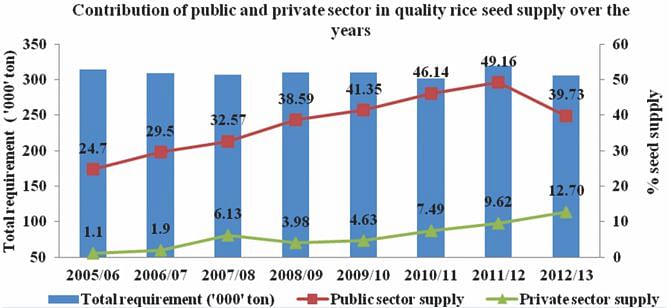Dilemma in quality rice seed production

IN Bangladesh, rice contributes more than 97% to the total cereal food supply. During the last three and half decades, although rice production increased more than three-fold because of rapid adoption of modern rice technology on a large scale, the country has not yet attained complete self-sufficiency in food.
Since horizontal expansion of areas under crop production is almost impossible, the possibility of increasing rice production will depend mainly on: (i) bringing more areas under the varieties with potentiality of breaking the current rice yield ceiling, (ii) enhancing crop production through quality input, etc. Good seeds play a vital role in maximum exploitation of yield potential of any crop variety. Experimental results clearly imply that rice yield could be increased by 12%-15% by using good quality healthy seeds alone, and nearly 20 lac tones of additional rice may be obtained per annum.
There has been a wide gap between the requirement and supply of quality rice seeds in the past. However, the level of requirement of rice seed has been almost similar over the years 2005 to 2013, which is in line with the trend in providing land for cultivation of high yielding modern rice varieties.
Bangladesh Agricultural Development Corporation (BADC) and the Department of Agricultural Extension (DAE) have been the main public organisations in producing and supplying the quality seed to the farmers. Moreover, there are some NGOs and private sector organisations (e.g. Brac, Lal teer, Syngenta, ACI etc.) involved in seed production and multiplication activities. Although both public and private sectors contribute to the supply of quality seeds, the volume has never been at a satisfactory level. In fact, the share of quality seed supply relative to the total requirement has always been dissatisfactory.
During the period 2005 to 2012 the share of quality seed supply relative to the requirement varied from 25% to 58% in different years. It is therefore clear that the combined effort of public and private sectors had been able to meet on average only about 41% of the total requirement, indicating that, on average, about 59% seeds are being used from seeds retained by the farmers. Although the public sector supply of quality rice seed compared to the demand/requirement increased from 24% in 2005 to 49% in 2012, this share declined remarkably in the following year, while the private sector share increased from 1.1% in 2005 to 9.6% in 2011, which increased to 12.7% in 2013.
Overall, quality rice seed production increased over the period 2005 to 2012 with slight decrease in 2013, when the share of public sector production declined substantially leaving more space for private sector initiative. Different NGOs and seed companies are involved in hybrid seed multiplication and marketing. Some seed companies are involved in inbred seed multiplication taking breeder's seeds from the research institutes. Farmers have no control over the agricultural inputs, except for seed. They use their own saved seeds, which are usually not tested for quality.
Quality and performance of such retained seeds and certified seeds differ quite significantly, as depicted by the results of scientific research. Furthermore, experiences indicate that farmers usually retain seeds for several years and keep on using them. Consequently, the level of seed admixture increases and quality deteriorates, causing low level of germination. Continuous use of such poor seed leads to lower yield for obvious reasons.
Therefore, if farmers could be empowered with knowledge of producing and using quality seeds, it could boost rice production significantly. Besides, seed replacement rate at the farmers' level is very low. A strong and resilient rice seed sector addressing the specific needs of the poor farmers for timely access to quality seed can play a crucial role in ensuring food security and rural economic development in the country. Acceleration of the seed system will help increase the supply of quality seeds, which would help enhance productivity and eventually result in reducing poverty and thus ensure food security in Bangladesh.
The writer is the former Chief Economist at BRRI, Gazipur. Currently affiliated with FAO of the United Nations attached with Food Planning and Monitoring Unit at Ministry of Food, Dhaka.
Email: [email protected]

 For all latest news, follow The Daily Star's Google News channel.
For all latest news, follow The Daily Star's Google News channel. 



Comments